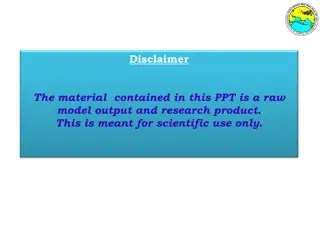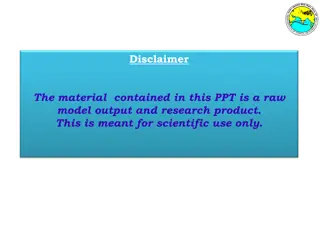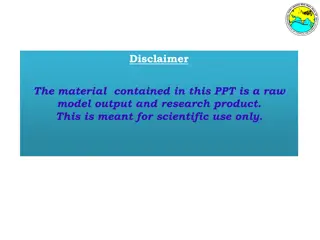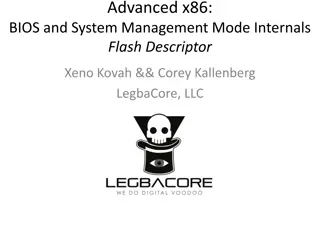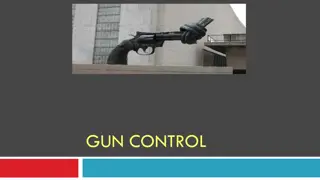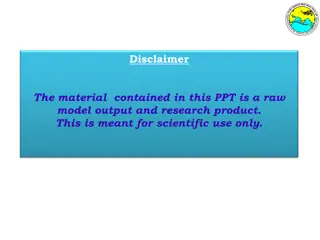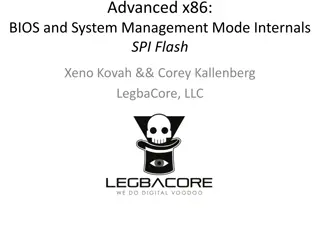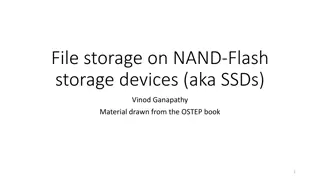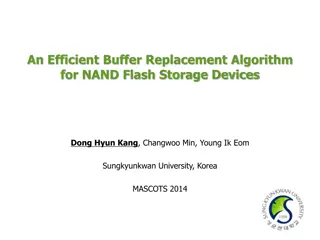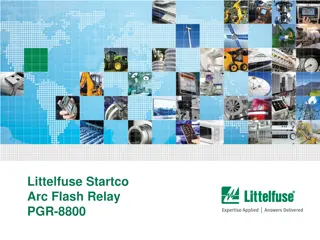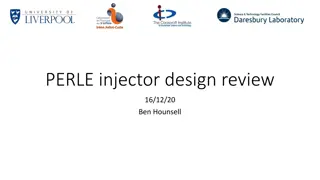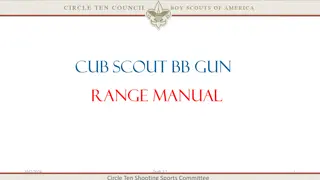FLASH RF Gun Developments Seminar Highlights
Explore the advancements in FLASH RF gun developments presented by Sven Pfeiffer during the LLRF team FEL Seminar. Topics discussed include LLRF feedback, pulse width modulation, RF gun cooling systems, fast protection measures, and current challenges post-startup, offering valuable insights into precision temperature control and regulation techniques.
Download Presentation

Please find below an Image/Link to download the presentation.
The content on the website is provided AS IS for your information and personal use only. It may not be sold, licensed, or shared on other websites without obtaining consent from the author.If you encounter any issues during the download, it is possible that the publisher has removed the file from their server.
You are allowed to download the files provided on this website for personal or commercial use, subject to the condition that they are used lawfully. All files are the property of their respective owners.
The content on the website is provided AS IS for your information and personal use only. It may not be sold, licensed, or shared on other websites without obtaining consent from the author.
E N D
Presentation Transcript
FLASH RF gun developments. Sven Pfeiffer for the LLRF team FEL Seminar Hamburg, 19.04.2016
Outline > Introduction > LLRF Feedback & Limitations Learning Feedforward > Pulse Width Modulation RF gun cooling system Temperature estimation Precision temperature control > Fast Protection The why and wherefore > Current problems After start-up Sven Pfeiffer | FLASH RF gun developments | 19.04.2016 | Page 2
Outline > Introduction > LLRF Feedback & Limitations Learning Feedforward > Pulse Width Modulation RF gun cooling system Temperature estimation Precision temperature control > Fast Protection The why and wherefore > Current problems After start-up Sven Pfeiffer | FLASH RF gun developments | 19.04.2016 | Page 3
Introduction 1.3 GHz SWS, Pulsed mode @ 10 Hz, Forward power 5 MW (average power 50 kW) Pulse length up to 800 s (1) Regulation - LLRF: Control the amplitude and phase of virtual probe signal 1% duty cycle Since 01/2015 operated with MicroTCA.4 (2) Regulation - Water: Control the RF gun temperature keep it on (slightly below) its resonance frequency (3) Protection: Limiter for Output, FB, LFF etc. Switch off the power to RF gun if necessary, e.g. spark Sven Pfeiffer | FLASH RF gun developments | 19.04.2016 | Page 4
Outline > Introduction > LLRF Feedback Loop Concepts & Achievement > Pulse Width Modulation RF gun cooling system Temperature estimation Precision temperature control > Fast Protection The why and wherefore > Current problems After start-up Sven Pfeiffer | FLASH RF gun developments | 19.04.2016 | Page 5
LLRF Regulation Main.GUN Panel LLRF > Ampl. SP [MV/m] (new: before power SP [MW]) > Phase SP [deg] > Pulse length [ s] > Feedforward > Feedback > OVC, LFF etc. Sven Pfeiffer | FLASH RF gun developments | 19.04.2016 | Page 6
LLRF Regulation Sven Pfeiffer | FLASH RF gun developments | 19.04.2016 | Page 7
LLRF Regulation Small signal system model System model FPGA output to virtual probe Identified parameters: I/Q gains as function of frequency Cross-couplings Bandwidth ~ 52 kHz Loop delay 1.4 s Model based optimization of FB and LFF Feedback loop Sven Pfeiffer | FLASH RF gun developments | 19.04.2016 | Page 8
LLRF Regulation Goal: dA/A<0.01% d Feedback concepts <0.01 deg (rms) 1) Output-Vector Correction (OVC - Server) Drift compensation 2) Learning Feedforward (LFF - Server) Minimize repetitive errors from pulse to pulse 3) MIMO feedback (FB - FPGA) Intra-pulse feedback Main limitation: Loop delay 1.4 s limits control gain max. FB gain 2-3; SRF 20-40 (!) Sven Pfeiffer | FLASH RF gun developments | 19.04.2016 | Page 9
LLRF Regulation Goal: dA/A<0.01% d <0.01 deg (rms) PI feedback Sven Pfeiffer | FLASH RF gun developments | 19.04.2016 | Page 10
LLRF Regulation Goal: dA/A<0.01% d <0.01 deg (rms) 0.01% 9MHz 100kHz Factor 3-5 improvement necessary 0.01deg. PI feedback Sven Pfeiffer | FLASH RF gun developments | 19.04.2016 | Page 11
Outline > Introduction > LLRF Feedback & Limitations Learning Feedforward > Pulse Width Modulation RF gun cooling system Temperature estimation Precision temperature control > Fast Protection The why and wherefore > Current problems After start-up > Outlook Sven Pfeiffer | FLASH RF gun developments | 19.04.2016 | Page 12
RF gun cooling system Cold water > GUN Wasser Valves RF gun Temperatur Wasserkreislauf Warm water Tank Heater Sven Pfeiffer | FLASH RF gun developments | 19.04.2016 | Page 13
RF gun cooling system Long term error 1 bit (about 14mK rms) @Resolution (12 bit ADC) of 0.02 K 0.03 K Required stability for d < 0.01 deg without LLRF control: ??? ? ? 2 ????? ?? ? 2 ????? ?? = < ?.????, (? = 1.3???,??= 12000,???= 21???/?) Sven Pfeiffer | FLASH RF gun developments | 19.04.2016 | Page 14
RF gun cooling system Pressure +0.09bar Long term error 1 bit (about 14mK rms) TIRIS +100mK @Resolution (12 bit ADC) of 0.02 K 0.03 K Required stability for d < 0.01 deg without LLRF control: ??? ? ? 2 ????? ?? ? 2 ????? SASE -35uJ ?? = < ?.????, (? = 1.3???,??= 12000,???= 21???/?) Sven Pfeiffer | FLASH RF gun developments | 19.04.2016 | Page 15
Pulse Width Modulation Idea: Usage of LLRF Signals Use pulse width modulation to control the dissipated power (heat balance) to the RF gun body within pre-defined limits Needed is a high precision temperature estimation with no time delay for pulse to pulse feedback Sven Pfeiffer | FLASH RF gun developments | 19.04.2016 | Page 16
Pulse Width Modulation Idea: Usage of LLRF Signals Delayed TIRIS (9s) and TIN (5s) information Transition from cavity body to sensor Low pass behavior of temp. sensor FLASH RF GUN data Temp. sensor (12 bit ADC) Sven Pfeiffer | FLASH RF gun developments | 19.04.2016 | Page 17
Pulse Width Modulation Blue: single pulse, Red: mean 100 pulses (10s@10Hz) > RF GUN phase at 1st beam position (700 s) for 50 minutes > Without and with modulation to minimize disturbances from cooling water circuit Pulse to pulse compensation (10 Hz) > Improvement for phase x3 (d = 53 mdeg. 16 mdeg.) > RF GUN temperature stabilized by x5 (from 14 mK 3 mK) > Running @ FLASH, PITZ, (XFEL) Sven Pfeiffer | FLASH RF gun developments | 19.04.2016 | Page 18 * Under review @ Physical Review Special Topics - Accelerators and Beams
Pulse Width Modulation Goal: dA/A<0.01% d <0.01 deg (rms) Remember: > Factor 3-5 improvement in phase is necessary using only LLRF 0.01% control Applying PWM: > No improvement of RF amplitude Detuning affects mainly the RF phase > Great improvement in standard deviation of RF phase > Achieved by using disturbance 0.01deg. minimization of detuning with precision temperature control Sven Pfeiffer | FLASH RF gun developments | 19.04.2016 | Page 19
Pulse Width Modulation Panel > PWM Feedback check box > Set-point (automatically computed) > Status indicator > Initialization (settings before PWM) > Manual (set-up, problem handling) > With Pulse Width Modulation > Start-up of RF gun next slide > Without Pulse Width Modulation Sven Pfeiffer | FLASH RF gun developments | 19.04.2016 | Page 20
Additional Info > Using pulse width modulation panel for start-up of RF gun Direct response RF gun is in resonance, to cold or to warm Relative detuning / temperature information What is the current optimal Iris set-point etc. Temperature TIRIS and set-point Flattop length Sven Pfeiffer | FLASH RF gun developments | 19.04.2016 | Page 21
Outline > Introduction > LLRF Feedback & Limitations Learning Feedforward > Pulse Width Modulation RF gun cooling system Temperature estimation Precision temperature control > Fast Protection The why and wherefore > Current problems After start-up Sven Pfeiffer | FLASH RF gun developments | 19.04.2016 | Page 22
Fast Protection > Implementation in FPGA (L. Butkowski, C. Schmidt et al.) > Threshold for reflected signal is defined (scaled by forward signal) > Cut RF pulse if reflected signal is too high (sparks, detuning, etc.) Sven Pfeiffer | FLASH RF gun developments | 19.04.2016 | Page 23
Fast Protection > 6 Events since 01/2016 no known false alarms phase jump Reference timing (?) unknown pressure pressure concept Test of Water Water RF-6 Sven Pfeiffer | FLASH RF gun developments | 19.04.2016 | Page 24
Outline > Introduction > LLRF Feedback & Limitations Learning Feedforward > Pulse Width Modulation RF gun cooling system Temperature estimation Precision temperature control > Fast Protection The why and wherefore > Current problems After start-up Sven Pfeiffer | FLASH RF gun developments | 19.04.2016 | Page 25
Current Problems > After RF gun start-up Phase at end is not on set-point > How to check? Look in LFF panel Sven Pfeiffer | FLASH RF gun developments | 19.04.2016 | Page 26
Current Problems > RF gun start-up without FB, LFF t = 0 (1) Adjust OVC before FB and LFF is enabled (2) Enable FB, LFF FF correction are centered after a while FF correction limits: 7000 bits t = 0 (3) FF correction tables 20 minutes later (4) After 40 minutes t = 20 min FF tables (Q channel) hits limit readback set-point Why? Slowly waveguide heating (guess) t = 40 min Sven Pfeiffer | FLASH RF gun developments | 19.04.2016 | Page 27
Current Problems > After RF gun start-up Phase at end is not on set-point t = 40 min t = 40+x min > Why? Slowly waveguide heating (guess) > How to check? Look in LFF panel > What can I do? Adjust OVC phase by ~ -4 deg Sven Pfeiffer | FLASH RF gun developments | 19.04.2016 | Page 28
Current Problems > After RF gun start-up Phase at end is not on set-point t = 40 min t = 40+x min > Why? Slowly waveguide heating (guess) > How to check? Look in LFF panel > What can I do? Adjust OVC phase by ~ -4 deg > Why is it not done automatically? Most of the time OVC is OFF OVC ON does not mean that its active Active limiter deactivate OVC Sven Pfeiffer | FLASH RF gun developments | 19.04.2016 | Page 29
Outline > Introduction > LLRF Feedback & Limitations Learning Feedforward > Pulse Width Modulation RF gun cooling system Temperature estimation Precision temperature control > Fast Protection The why and wherefore > Current problems After start-up Sven Pfeiffer | FLASH RF gun developments | 19.04.2016 | Page 30







